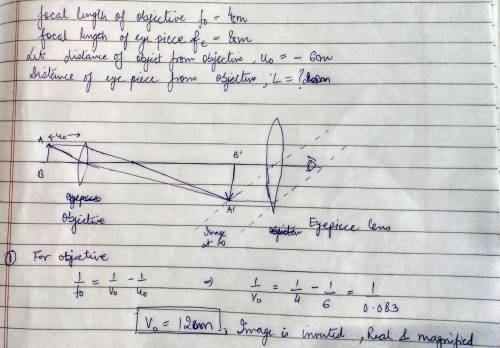
CI. Design challenge: Your goal is to build a compound microscope than can at least double the size of the object. We will constrain ourselves to values that will work later in a simulation, which has the unrealistic- for microscopes - focal lengths in meters. (Imagine instead that those values are in cm) You need to choose two converging lenses. You have available lenses with focal lengths of 2, 4, 8 and 12 m. First choose an objective lens focal length, and a distance to place the object from the lens. Then choose an eyepiece lens focal length and a distance to place the lens from the objective lens. C2. Draw your microscope design including a ray diagram. Your diagram should include: 1. Location and properties (real/virtual, upright/inverted, bigger/smaller) of the image formed by the objective. 2. Location and properties (real/virtual, upright/inverted, bigger/smaller) of the image formed by the eyepiece. C3. Calculate the magnification of your microscope

Answers: 3
Another question on Physics

Physics, 21.06.2019 22:30
Follow these directions and answer the questions. 1. shine a pencil-thin beam of light on a mirror perpendicular to its surface. (if you don't have a laser light as suggested in the video, you can make a narrow beam from a flashlight by making a cone from black construction paper and taping it over the face of the flashlight.) how does the light reflect? how does the relationship of incident to reflected ray relate to the reflection of water waves moving perpendicular to a barrier? 2. shine a pencil-thin beam of light on a mirror standing on a sheet of paper on the table (or floor) so that you can mark the incident ray and reflected ray. (you can support the mirror from the back by taping it to a wooden block.) 3. mark a line on the paper representing the reflective surface. (the reflective surface of a mirror is usually the back edge.) 4. draw a dashed line perpendicular to the mirror surface at a point where the incident and reflected ray meet. this perpendicular is called a normal to the surface. 5. measure the angles between the rays and the normal. the angle of incidence is the angle formed by the incident ray and the normal to the surface. the angle formed by the reflected ray and normal is called the angle of reflection (r). what is the angle of incidence? what is the angle of reflection? 6. repeat for several different angles. (see report sheet for details.) what appears to be the relationship between the angle of incidence and angle of reflection? in science 1204, what was the relationship for these two angles made by the reflection of waves in a ripple tank? 7. roll a ball bearing so that it hits a fixed, hard surface (a metal plate) at several angles (including head-on). observe the way in which the ball bearing reflects. what generalization can you make about how a ball bearing reflects from a wall? have you proved that light can only behave like a wave?
Answers: 1



Physics, 22.06.2019 10:00
Two objects of different mass start from rest, are pulled by the same magnitude net force, and are moved through the same distance. the work done on object 1 is 900 j. after the force has pulled each object, object 1 moves twice as fast as object 2. how much work is done on object 2?
Answers: 1
You know the right answer?
CI. Design challenge: Your goal is to build a compound microscope than can at least double the size...
Questions



Mathematics, 04.06.2020 19:00

Chemistry, 04.06.2020 19:00


Mathematics, 04.06.2020 19:00

Mathematics, 04.06.2020 19:00



Physics, 04.06.2020 19:00


Computers and Technology, 04.06.2020 19:00


Mathematics, 04.06.2020 19:00




Engineering, 04.06.2020 19:00


Social Studies, 04.06.2020 19:00






